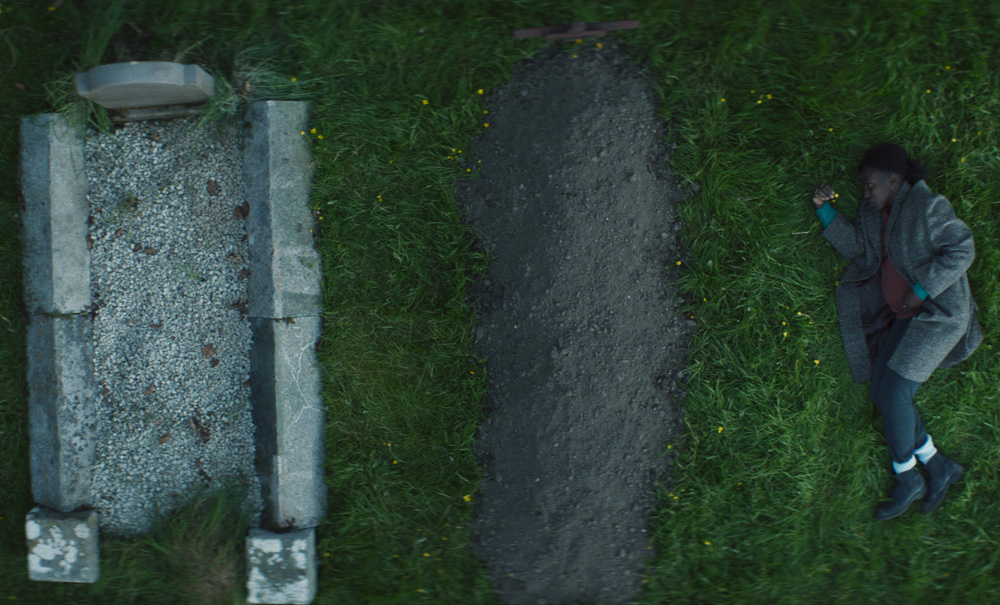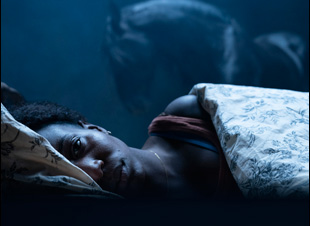Much like the rest of the world waiting out the coronavirus, Joe Marcantonio has been anxiously awaiting a return outdoors, particularly when all he’s been able to work on “Kindred,” a claustrophobic thriller set inside a house.
“We locked picture about 10 months ago and then we had to do the visual effects for the ending, which took longer than we thought and then a global pandemic isn’t the best thing,” Marcantonio laughs, making the best of a different plan for his debut feature to enter the world than he might’ve expected. “It feels a bit unreal at this point. You can’t really know what to expect, but we’ll see. No one’s seen the film. My parents haven’t even seen it yet, so we’ll see what happens. Hopefully [they] won’t disown me.”
As the director shows in “Kindred,” there are actually worse reactions for parents to have as he settles in with Ben (Edward Holcroft) and Charlotte (Tamara Lawrance), a couple expecting their first child. Currently living with his mother Margaret (Fiona Shaw) and half-brother Thomas (Jack Lowden) on a palatial estate impressive in its acreage yet increasingly dilapidated with only the small family taking care of it, the pair’s news is welcome when Margaret expects there will be another generation around to keep it going, but Ben has other plans, intending to start his family elsewhere when Charlotte, a product of the city has never felt at home on the countryside. She is made to feel it’s best for the unborn child not to leave before she gives birth, but increasingly that looks like a choice Charlotte won’t be making for herself as she begins experiencing nightmares and unfortunate incidents around the property that seem too unnatural to be coincidental.
Others have certainly found opportunities to find the horror in an impending pregnancy, but “Kindred” distinguishes itself early and often on in how Marcantonio, with co-writer Jason McColgan, so effectively realizes how Charlotte’s frayed nerves manifest themselves into her everyday life and considers just how much she is up against when she and Ben’s desire to check out of the manor isn’t only leaving behind the dead end of a diminishing family legacy but breaking free of nothing less than the continuity of the British class system. With an eye for detail and a feel for the deeply unsettling, the writer/director has made a film worth staying in for, even if it makes you want to crawl out of your skin and as “Kindred” is released across the world, he spoke about how he found a real house to film the entire production in, getting the entertaining yet grounded tone just right and the subtle aesthetic touches that make it so creepy.
I’d been a amateur screenwriter since I was about 13 [when] I wrote an alien movie, which thankfully I can’t find because it was horrific. But it’s something I’ve been keen to do, and it’s always quite hard to break into the industry. I didn’t really know the right people. When I started doing my own little short films, I was trying to find my voice and find my way to make a movie – and then I came up with this idea [for “Kindred”] about 10 years ago. It was just a bit dark and I didn’t know the best way to approach it, so I put it in a file and forgot about it and then wrote some other stuff. Then I went to a prenatal baby class, because when you’re having a kid, you’re going to one of those classes that teaches you how to have a kid and I sat next to this guy [who] looked similar and everyone else in the room looked kind of weird and at lunch, we were like, “You and your wife seem kind of normal. Let’s go grab a bite to eat.” It turned out the guy was a film producer. [laughs]
We got friendly and our kids were born around the same time, so we decided to do a film together — a short [“Red Light”] at first, which we did, which has Jessie Buckley in it, and then after we finished that and it went really well, he’s like, “Well what feature do you want to do?” And the films I’d written up to that point are not really suitable for a first-time [feature filmmaker]. They’re a bit big and sprawling and too many cast, so I decided we needed to write something that is a small amount of characters and a limited amount of locations, and when I went through my list of ideas, all of a sudden, this one popped out. Having had a kid and having had another on the way at this point, it spoke to me in a way it hadn’t before and I saw a way into it I hadn’t before, so I drafted in my friend Jason from film school, and he was expecting twins at the same time, and we set about writing it.
Did you actually have a location in mind? It’s got an amazing setting.
Growing up in England, we’re not short of a few manor houses, but they all tend to be either done up with a car park and a cafe in them for tourists to come around or they’re so crumbling that they’ve fallen apart that no one can look after them. The way the class system is in this country, it’s a real problem for people that if you inherit these houses — every time a generation dies, the government comes and takes 40% of your earnings and you’re left with less money to try and keep this house that’s been in your family for 400 years. When your generation dies and [it’s] your kids, they’ve got 40 percent less than that, so it’s a constant issue for these families.
We went to Ireland because [of incentives], and we tried to find this place, but all the ones we found were not quite right or had been turned into a hotel and spa or a wedding venue. We kept hearing whispers about Stradbally and no one had really shot there because it’s so far out of Dublin, it’s difficult to shoot in. You have to put crew up and it’s hard to get kit delivered, but for us, it was perfect. As soon as we saw it, I was like [to the producer], “I know what you’re going to say. This is going to cost a fortune. But this is the perfect place.” So we just moved everyone in and we didn’t have winnebagos or trailers. Everyone just had a room – a room in the house for hair, a room in the house for makeup, a room in the house for each of the cast – even I had a little room. [laughs] I think I went in it twice to calm down and that’s about it.
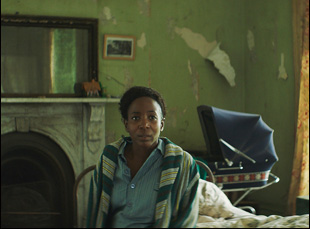
Part of the process I go through in refining the script is rather than having a traditional rehearsal period where you go to the house and act out the scenes – I like to workshop the script with the actors. We’ll sit in a room together in a circle and go through the script literally line by line and say, “Now okay, Margaret says, ‘You can’t leave me here,’ and [Fiona Shaw would] say, “Why does she say that?” By her very nature, Fiona works best when she is holding something in and her ability to play that is just out of this world, so I’d give an explanation of why she says that and Fiona would give a bit of feedback and we’d either agree on that line or she’d say, “Rather than saying, “You can’t leave me here,” [it could be] “You can’t leave me here like this.” So we’d have a bit of collaboration on some specifics. It means that the actors feel invested in their characters, and when that happens, they tend to self-police themselves a little on set. If they think they’re going too big, they’ll say to me, “I think we’re going a bit big, can I do that again?” and I’ll say to them, a little bit too much,” and it’s just trying to find that right balance.
Did you have music in mind from the start as well? There’s some scenes, specifically when Charlotte’s attempting to escape in one scene, where you let the music take over and you realize when the dialogue cuts out entirely that classical music in the car makes it as if she’s fighting the weight of history.
Yeah, hugely. I think most writers do, but I make a little playlist of all the stuff I’m into. [For this] there were a lot of Bernard Herrmann scores, “Psycho” particularly, and when it came into the edit, I knew there would be “Clair de lune,” and [we’d have] “Dream a Little Dream” [at central moments] – we tried to get that for the end title sequence and it was all agreed and at the last minute, they wanted more money, which was really annoying because it was a bit of a happy moment in the end titles, and it was taken away – [like] “get rid of the happiness, it’s fine.” [laughs]
Then as far as piece over the car [scene], it was actually my editor Fiona de Souza’s idea when we were editing the dialogue and getting it to match. Fiona’s an amazing editor who had worked with Park Chan-Wook on a TV series “The Little Drummer Girl”, [which is] one of the reasons I picked her – and she said, “We’ll just play one of our bits of music that we’ve got and see if it works.” For that escape, we shot it [originally] as a whole single shot, all the way through the bedroom out to the gate and beyond and it stayed that way, [which is about] seven minutes in the film and just as we were putting the film together, it killed me to have to cut into it because it was just too long. It’s a single take now as she gets into the car and drives away, so it’s still the same take the whole time, but we just had to take a little chunk out of it here and there.
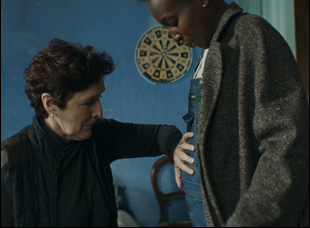
Yeah, that scene in particular was hard because the day before, we had shot the end scene with [Charlotte] shouting — not to ruin it for people — so when we came to shoot that scene in the hospital room, [Tamara Lawrence] had lost her voice, so was talking like this – [in a whisper] when she went in to talk to the stenographer [at the hospital]. So it worked really well. It was like a happy accident. We’d designed a lot of those shots in preproduction so that we could try and build tension in that way, and have enough to cut to. The worst thing in the edit is to not have enough cutaways.
There’s also a subtle thing visually that really allows you to feel the tension inside the house when you go outside. How did you figure out how to shoot this?
I’m a fan of trying to inject the themes of the film into every aspect of it and we did that with color palette, so you’ll notice wardrobe-wise Thomas and Margaret’s clothes match the house — the props, the wallpaper and the pictures — but when Charlotte comes into the house, she’s wearing brighter colors that clash. Then when she wakes up in the house, they put her in clothes that match the house and then as she starts feeling rebellious and wants to escape and every time she’s having a thought that this may not be the place for her, she’s wearing a color that clashes again, so it’s just thinking about what the characters are going through and trying to do that with the art department.
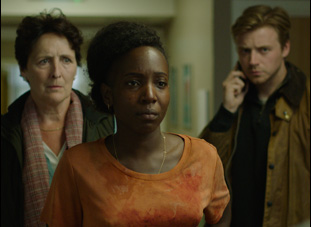
“Kindred” is now open in select theaters and available on demand and Amazon and iTunes.




